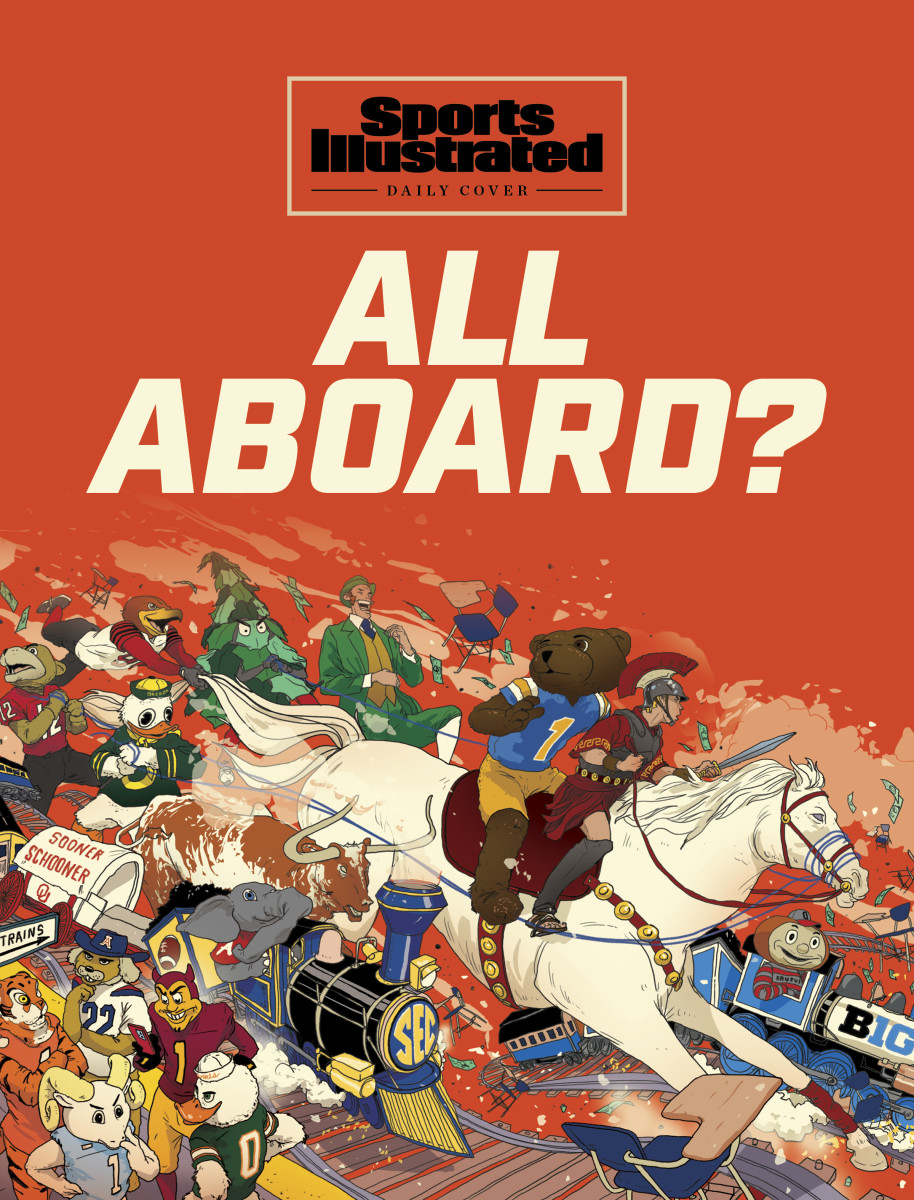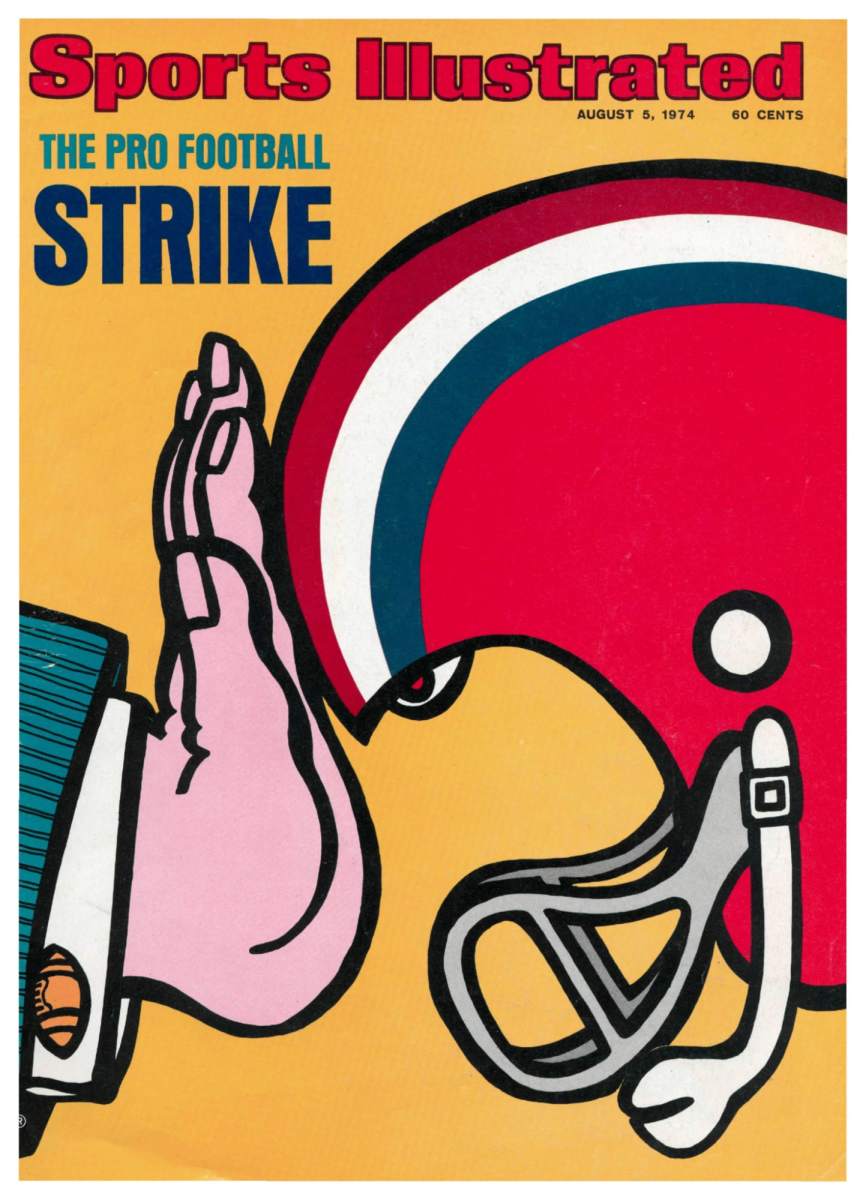SI:AM | Manchester City Goes for the Three-peat
Good morning, I’m Dan Gartland. I can finally enjoy my favorite weekend morning activity again: watching European soccer in my pajamas.
In today’s SI:AM:
🏈 The future of college football
🏀 Brittney Griner’s Russian prison sentence
If you're reading this on SI.com, you can sign up to get this free newsletter in your inbox each weekday at SI.com/newsletters.
Can anybody stop Manchester City?
If you felt butterflies watching the lousy Hall of Fame game last night, imagine how sports fans in England are feeling today as the English Premier League season begins.
The opening game isn’t a marquee matchup by any means—Arsenal vs. Crystal Palace—but every match matters in the Premier League. That fixture gets things started before the action kicks into high gear with six games tomorrow and three on Sunday. Here are a few of the biggest things to know for the season ahead:
The defending champs
Manchester City has been a juggernaut for a while now. The club hasn’t finished outside the top four since 2010, a time during which the club has won six Premier League titles (including four of the last five).
The rich got richer this summer, adding the biggest transfer target in years—22-year-old Norwegian striker Erling Haaland—from Borussia Dortmund. He will replace Gabriel Jesus, who was sold to Arsenal. Haaland is a much more prolific scorer than Jesus, but he’s a different kind of player. It will be a challenge for the club to adjust to having Haaland as the new focal point of the attack, Jonathan Wilson writes:
Haaland is not a classic Pep Guardiola-style forward. He looks as though he was brought to life in a tower at midnight during a storm. He batters defenders out of the way, at times makes the game look gloriously simple, barging through opponents and smashing in shots. It may be that he gives City an edge it has previously lacked in the biggest European games. But equally there is a risk that he disrupts a precision-based system that has brought so much success.
The battle for the top four
City is the oddsmakers’ favorite to win the title, followed closely by Liverpool. The third tier of contenders features Tottenham, Chelsea, Arsenal and Manchester United. In all likelihood two of the teams in that group will be on the outside looking in of the crucial top four. The first four teams in the standings at the end of the season earn a spot in the Champions League, with the fifth-place team going to the Europa League. England traditionally has six major clubs, so one always gets left out in the cold. Who will it be this year?
Maybe Manchester United
United won’t be playing European football this season after finishing sixth in the Premier League last season and the club hired manager Erik ten Hag to turn things around. But the summer has been rocky, Wilson writes. United has tried to sign Barcelona’s Frenkie de Jong, who played under ten Hag at Ajax, but the young midfielder has rebuffed the club’s advances because of its reputation as being “erratic”:
That means that with a month of the transfer window remaining, United remains short of a commanding central midfielder. It hasn’t brought in a right back either, while center forward remains a problem not least because Cristiano Ronaldo is still at the club despite spending most of the summer trying to leave. With very few clubs seemingly interested in signing him, repeated talks have failed to resolve the issue, and over the weekend, having tweeted, “Sunday, the King plays,” he was subbed off at halftime and left Old Trafford before the end of United’s friendly draw against Rayo Vallecano.
That leaves United with less than a month before the Sept. 1 transfer deadline to cobble together a Champions League-worthy roster and figure out the Ronaldo situation.
The Cinderella
Watford, Burnley and Norwich City were relegated from the Premier League last season and will be replaced by Fulham, Bournemouth and Nottingham Forest. While Fulham and Bournemouth have been yo-yoing between the Premier League and the second-tier Championship in recent years, Forest hasn’t played in England’s top flight since 1999.
Forest was once one of the continent’s top teams, winning the European Cup (the precursor to today’s Champions League) in 1979 and ’80. The club tumbled as low as the third-tier League One before beginning its climb back to the Premiership. It finished fourth in the Championship last season and achieved relegation via the playoffs. To bolster their hopes of staying in the Premier League, Forest has spent over $100 million in transfer fees to bring in new players. The biggest signings were Nigerian striker Taiwo Awoniyi (who was signed for a club-record $22.5 million) and right back Neco Williams ($20 million). Forest also signed Jesse Lingard from Manchester United on a free transfer.
The best of Sports Illustrated

Today’s Daily Cover is a staff roundtable about the current uncertainty facing college football, particularly surrounding conference realignment.
Michael Rosengberg writes that it’s far from a guarantee that Brittney Griner’s story has a happy ending. … Ben Pickman spoke to people with the Mercury about Griner’s conviction. … Here are a few MLB trade deadline acquisitions that Nick Selbe thinks flew under the radar. … Albert Breer visited Broncos camp and came away very impressed.
Around the sports world
Whit Merrifield decided to get vaccinated after being traded to the Blue Jays. … A fifth-tier English soccer team inadvertently named part of its stadium after a serial killer. … An A’s prospect became the first player in pro baseball history to hit inside-the-park home runs in consecutive games. … A rare Honus Wagner card sold for a record price of over $7 million. … Clayton Kershaw left yesterday’s game against the Giants with an apparent injury. … Glenn Jacobs, the pro wrestler known as Kane, was re-elected as mayor of Knox County, Tenn.
The top five...
… things I saw yesterday:
5. Bill Belichick’s footwear choice for Patriots practice.
4. Taijuan Walker’s reaction to hearing Edwin Díaz would be going for a six-out save. (He converted it.)
3. Shohei Ohtani’s two-homer day. (The Angels hit seven homers and still lost.)
2. Rockies outfielder Sam Hilliard’s home run robbery.
1. The 42-second moment of silence in honor of Brittney Griner before the Mercury-Sun game.
SIQ
Which country won the first Olympic gold medal in baseball on this day in 1992? (Hint: it’s the country with the most Olympic baseball golds.)
Yesterday’s SIQ: On Aug. 4, 1982, who became the only player in MLB history to pick up two hits for two different teams in two different cities?
Answer: Joel Youngblood. He started the day with the Mets, who were playing a day game at Wrigley Field (the Cubs wouldn’t install lights until 1988). He went 1-for-2 before being pulled from the game in the third inning and informed he was being traded to the Expos.
But his day wasn’t over. Youngblood was told that the shorthanded Expos wanted him to get to Philadelphia for a game that night.
“It was a Saturday, so being on a road trip, you’re not packed,” Youngblood told MLB.com last year. “You gotta go change, take a shower, pay your incidentals, get a cab, go to the hotel, pack your stuff, pay your incidentals, go back and get in a cab, and there was only one flight I could catch. It was a 6:05 p.m. flight, which was 7:05 p.m. Philadelphia time.”
In the cab on the way to the airport, Youngblood realized he had left his glove at Wrigley, the one he had used for his entire career. After a pit stop at the ballpark to retrieve the glove, Youngblood dashed through the airport, made his flight and arrived at Veterans Stadium in time to play right field in the bottom of the sixth inning. In the top of the next inning, he picked up his second hit of the day, a single off of Steve Carlton.
From the Vault: Aug. 5, 1974

I wrote a little bit about the 1974 NFL strike in an SIQ early last month but I think it’s worth bringing up again—especially because of this cool illustrated cover.
As a refresher, the players went on strike in July of that year over what they called “freedom issues.” Their biggest concern was the so-called “Rozelle Rule,” which permitted the commissioner to assign compensation to teams losing free agents, but they were also hoping for things like less strict curfews during training camp.
During the strike, union members refused to report to training camp but the preseason moved forward with rookies and free agents, who were not members of the union.
The strike came to a head at the Hall of Fame game in Canton. As the “Cardinals” prepared to play the “Bills” (without basically any of their actual players), members of other labor unions came to support the striking NFL players. More than 100 members of the United Auto Workers stood on the picket line with the NFLPA and the league was worried that the labor solidarity could interfere with the game, Ray Kennedy wrote:
Perhaps panicked by the fact that the picketing players were joined by more than 100 of their brethren from the United Auto Workers, management devised one of the most elaborate logistical plans since the evacuation of Dunkirk. To confuse the enemy, the owners’ generals spread false rumors about the teams’ travel plans and where they would be billeted. No contingency was overlooked. The Cardinals, fearing their uniforms might be stolen in an attempt to sabotage the game, sent an empty equipment truck to the airport to see if anyone would try to hijack it. No one did.
As a safeguard against an entire team being kidnapped, two buses were dispatched to the Cleveland Browns’ training camp, and the players there were alerted to be ready to fill in as a whole spare team. Then, just three hours before game time, by secret prearrangement, the Bills and the Cardinals arrived simultaneously at the Akron-Canton Airport, just after Vice-President Gerald Ford and his Secret Service force landed in Air Force Two. Under heavy security—a helicopter flew overhead to spot possible roadblocks—the two clubs were whisked into the stadium through a back exit, guarded by mounted policemen.
(SI sent three photographers to Canton to cover the scene. Their photos were republished online on the 40th anniversary of the strike in 2014.)
But while other unions supported the NFLPA, public opinion—and even some former players— was decidedly in favor of the owners.
The oldtime players have also taken after the players. At Canton, former Detroit Lion star Leon Hart, who is the president of the NFL Alumni Association, and a group of his alums picketed the NFLPA pickets. “We feel the players are being led astray,” says Hart, “misguided into an indefensible position from which there eventually can be no return. In my opinion [NFLPA executive director] Ed Garvey is a weasel.”
The players are all too painfully aware of what the fans are thinking. Surveys taken around the country show overwhelming public support—80% and more in some cities—for the owners. Just as in the 1970 strike, the owners' PR has been far superior to the players’. The owners’ most winning move was to offer refunds for preseason games featuring the rookie legions.
The strike didn’t last long and was an undeniable failure. It ended on Aug. 10, with players returning to work without any of their demands having been met. Most crucially, their goal of achieving true free agency would have to wait until 1993.
Check out more of SI’s archives and historic images at vault.si.com.
Sports Illustrated may receive compensation for some links to products and services on this website.
